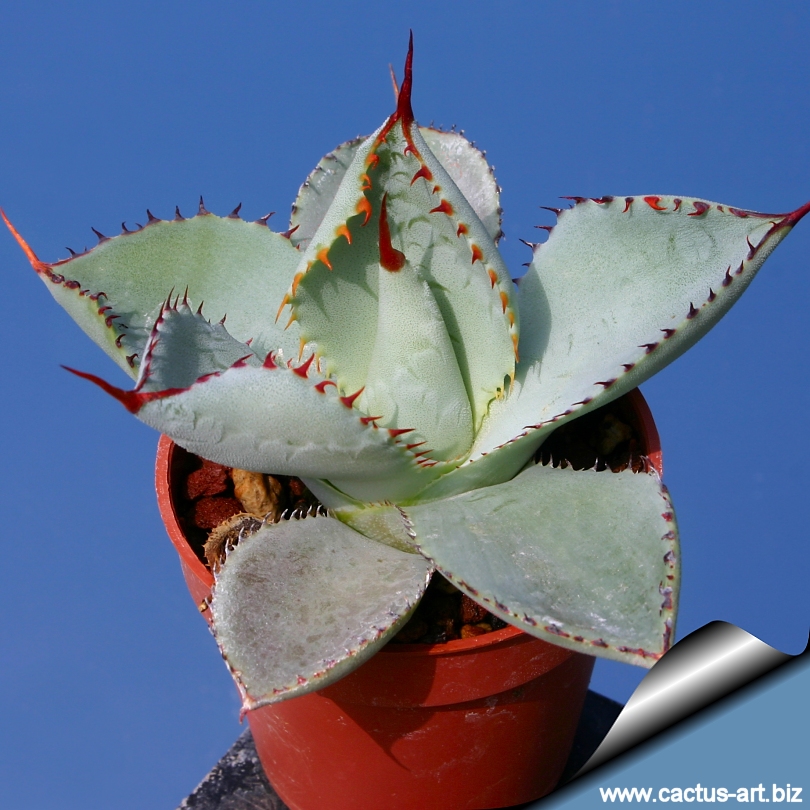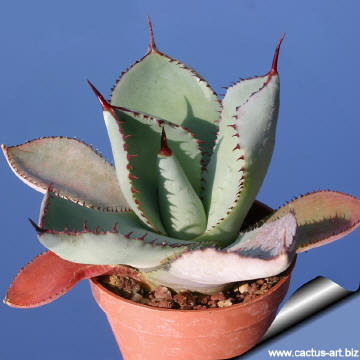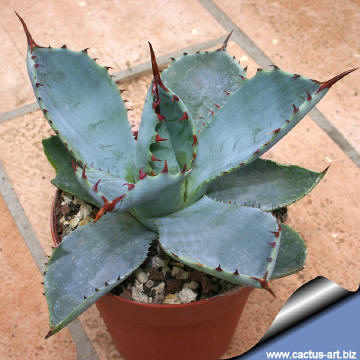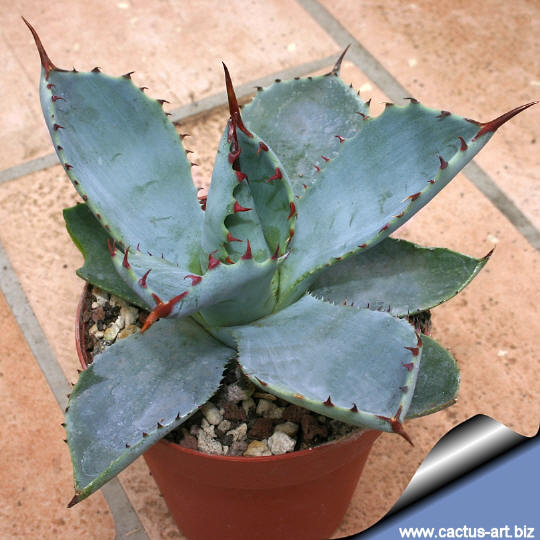|
|
|

Agave guadalajarana (A juvenile specimen)
This is a very striking
Agave with pale blue green, decoratively scalloped and slightly upcurved
leaves with large orange teeth along the margins. The young plants are
quite different from the adults, but are however very lovely too.
|
|
Description:
It is a usually solitary small tightly formed Agave, but suckers
occasionally. It forms compact rosettes 25-50 cm tall by 35-75 cm wide
(or more), broader than tall. It holds a lot of leaves for a larger
Agave.
Stem:
Acaulescent.
Leaves: Numerous, closely
imbricated, light greyish green , frosted blue greyish, some nearly
white, wide, short, flat, rigid, obovate to oblong, obtuse, 20-30 x 8-12
cm, slightly up-curved, the inner shiny glaucous, the outer dull grey,
closely imbricate. Leaves interestingly display prominent imprints from
unfurled leaves.
Leaves margin:
Mammillate with evenly large, orange, dark red-brown to dusty gray,
jagged teeth along the margins that become more numerous and larger
toward the leaf tip. The the upper teeth 8-10 mm long have often small
spines embedded in them, those from the mid-leaf to base much smaller,
3-4 mm long, 5 to 10 mm apart on nearly straight margin;.
Apical spine: Short, attractive up to 2.5 cm long, subulate,
greyish, straight to sinuous, flat to shallowly hollowed above, roundly
keeled below dark red-brow to tan.
Flowers: The inflorescence is a slender panicle, 4-5 m tall with
15 to 20 small umbels in upper half of shaft; "flowers 60 mm long";
tepals slender, much longer than tube; capsules 4.5 x 1.8 cm, stipitate,
shortly beaked, thick-walled, freely seeding. The tepals are usually
twice longer than the tube.
Seeds:
Lunate, 4x6 mm.
|
 |
 |
|
Advertising
|
|
|
|
|
|
|
Family: Agavaceae
Scientific Name:
Agave guadalajarana
Trelease.
In: Contr. U.S.
Nat. Herb. 23: 123, 1920.
Common (Mexican) Names include:
Maguey Chato
Origin: This
narrowly endemic species is known only from the environs of Guadalajara,
the capital of Mexican state of Jalisco
Type: 4473, on rocky summit of hills ca. 8 miles W of
Guadalajara, Jalisco, 22 June 1893, MO, isotypes K, US, MEXU.
Habitat: Grassy
slopes of oak woodland around 1,500 m elevations on volcanic rocky soils
but the plants often thrive on the slopes in almost pure rocks. The
climate is an open one below the Tropic of Cancer with a protracted dry
season from January to May.
|
|
|
|

Cultivation: A.
guadalajarana is a stunning specimen plant for containers
or a well drained spot in the gardennoted as rare in cultivation.
It tend to be
slow grower, but worth the effort. Grow them in porous soil
with adequate drainage. They do well in full
sun or a lightly shaded area.
Water thoroughly when soil is
dry to the touch. In winter watering this
plant can be done once every 1-2 months, there is no need to mist the
leaves. It is theoretically hardy to -3° C, particularly
when dry but it is best to avoid severe
freezing temperatures. Heat Tolerance: Excellent
Propagation:
Relatively easy to propagate by seeds or by
suckers (if available) Remove the basal suckers in spring or
summer and let the cuttings dry for a few days before inserting in
compost.. only problem is
the logistics of getting to the suckers - very sharp spines and suckers
usually right up against, or underneath the mother plant.
Use:
These striking plants are wonderful when used for accent or simply to
provide some all year round foliage colour and often used in a pot as a
patio plant, they make an eye-catching statement and along with other
evergreen plants in pots, can be moved around to change the scenery or
position to give more shelter.


|
|